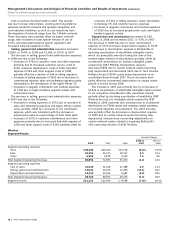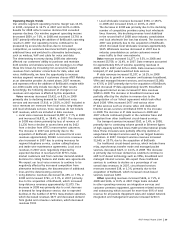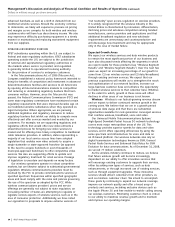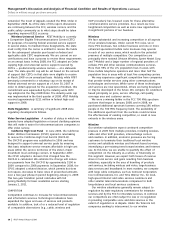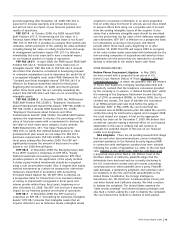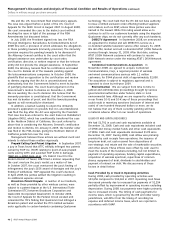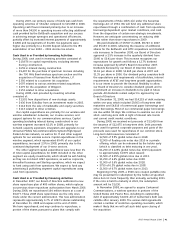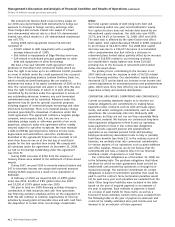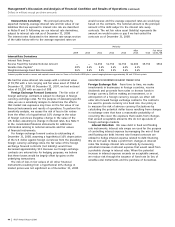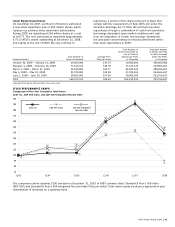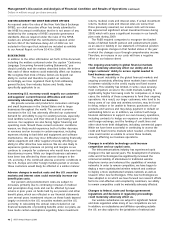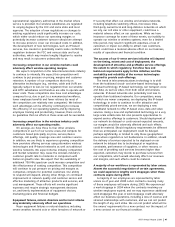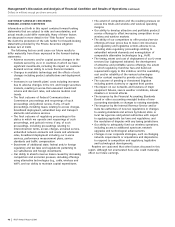AT&T Wireless 2008 Annual Report Download - page 40
Download and view the complete annual report
Please find page 40 of the 2008 AT&T Wireless annual report below. You can navigate through the pages in the report by either clicking on the pages listed below, or by using the keyword search tool below to find specific information within the annual report.
Management’s Discussion and Analysis of Financial Condition and Results of Operations (continued)
Dollars in millions except per share amounts
38
| AT&T Annual Report 2008
combined pension and postretirement cost to increase $650
over 2008. Under GAAP, the expected long-term rate of return
is calculated on the market-related value of assets (MRVA).
GAAP requires that actual gains and losses on pension and
postretirement plan assets be recognized in the MRVA equally
over a period of up to five years. We use a methodology,
allowed under GAAP, under which we hold the MRVA to within
20% of the actual fair value of plan assets, which can have
the effect of accelerating the recognition of excess actual
gains and losses into the MRVA in less than five years. We
expect that use of this policy will increase precapitalization
pension and postretirement costs by $1,577 in 2009.
This methodology did not have a significant additional
effect on our 2008, 2007 or 2006 combined net pension
and postretirement costs. Note 11 also discusses the effects
of certain changes in assumptions related to medical trend
rates on retiree health care costs.
Depreciation Our depreciation of assets, including use of
composite group depreciation and estimates of useful lives, is
described in Notes 1 and 5. We assign useful lives based on
periodic studies of actual asset lives. Changes in those lives
with significant impact on the financial statements must be
disclosed, but no such changes have occurred in the three
years ended December 31, 2008. However, if all other factors
were to remain unchanged, we expect that a one-year
increase in the useful lives of the largest categories of our
plant in service (which accounts for more than three-fourths
of our total plant in service) would result in a decrease of
approximately $2,160 in our 2009 depreciation expense and
that a one-year decrease would result in an increase of
approximately $3,390 in our 2009 depreciation expense.
Asset Valuations and Impairments We account for
acquisitions using the purchase method as required by
FAS141. Under FAS 141, we allocate the purchase price to
the assets acquired and liabilities assumed based on their
estimated fair values. The estimated fair values of intangible
assets acquired are based on the expected discounted cash
flows of the identified customer relationships, patents, trade-
names and licenses. In determining the future cash flows, we
consider demand, competition and other economic factors.
Customer relationships, which are finite-lived intangible
assets, are primarily amortized using the sum-of-the-months-
digits method of amortization over the period in which those
relationships are expected to contribute to our future cash
flows. The sum-of-the-months-digits method is a process of
allocation, not of valuation, and reflects our belief that we
expect greater revenue generation from these customer
relationships during the earlier years of their lives.
Alternatively, we could have chosen to amortize customer
relationships using the straight-line method, which would
allocate the cost equally over the amortization period.
Amortization of other intangibles, including patents and
amortizable tradenames, is determined using the straight-line
method of amortization over the expected remaining useful
lives. We do not amortize indefinite-lived intangibles, such as
wireless FCC licenses or certain tradenames (see Note 6).
Goodwill and wireless FCC licenses are not amortized but
tested annually for impairment in accordance with Statement
of Financial Accounting Standards No. 142, “Goodwill and
Other Intangible Assets” (FAS 142). We review other long-
lived assets for impairment under Statement of Financial
Accounting Standards No. 144, “Accounting for the
Impairment or Disposal of Long-Lived Assets” whenever
events or circumstances indicate that the carrying amount
may not be recoverable over the remaining life of the asset
or asset group. In order to determine that the asset is
recoverable, we verify that the expected future cash flows
directly related to that asset exceed its fair value, which is
based on the undiscounted cash flows. The discounted cash
flow calculation uses various assumptions and estimates
regarding future revenue, expense and cash flows projections
over the estimated remaining useful life of the asset.
Cost investments are evaluated to determine whether
mark-to-market declines are temporary and reflected in other
comprehensive income, or other than temporary and recorded
as an expense in the income statement. This evaluation is
based on the length of time and the severity of decline in the
investment’s value. At the end of 2008, we concluded the
severity of decline in the latter half of 2008 had led to an
other than temporary decline in the value of assets contained
in an independently managed trust for certain BellSouth
employee benefits (see Note 11).
Income Taxes Our estimates of income taxes and the
significant items giving rise to the deferred assets and
liabilities are shown in Note 10 and reflect our assessment
of actual future taxes to be paid on items reflected in the
financial statements, giving consideration to both timing
and probability of these estimates. Actual income taxes
could vary from these estimates due to future changes in
income tax law or the final review of our tax returns by
federal, state or foreign tax authorities.
In 2007, we adopted Financial Accounting Standards
Board Interpretation No. 48, “Accounting for Uncertainty in
Income Taxes” (FIN 48) and began accounting for uncertain
tax positions under the provisions of FIN 48. As required by
FIN48, we use our judgment to determine whether it is
more likely than not that we will sustain positions that we
have taken on tax returns and, if so, the amount of benefit
to initially recognize within our financial statements.
We regularly review our uncertain tax positions and adjust
our unrecognized tax benefits in light of changes in facts
and circumstances, such as changes in tax law, interactions
with taxing authorities and developments in case law.
These adjustments to our unrecognized tax benefits may
affect our income tax expense. Settlement of uncertain
tax positions may require use of our cash.
New Accounting Standards
FAS 161 In March 2008, the Financial Accounting Standards
Board (FASB) issued Statement of Financial Accounting
Standards No. 161, “Disclosures about Derivative Instruments
and Hedging Activities, an amendment of FASB Statement
No.133” (FAS 161). FAS 161 requires enhanced disclosures
about an entity’s derivative and hedging activities to improve
the transparency of financial reporting. It is effective for
financial statements issued for fiscal years and interim


